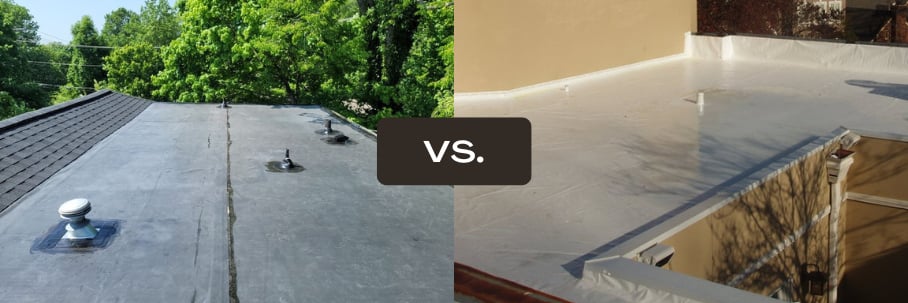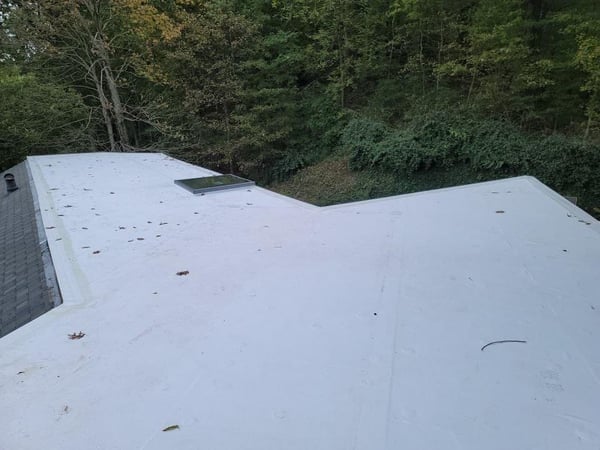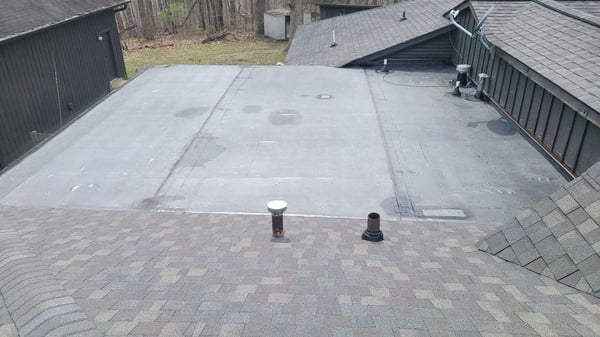TPO Roofing vs. EPDM Roofing: Which Membrane is Right for You?

Membrane roofing is a popular choice for commercial properties. However, it’s also popular for the flat or low slope roof areas on commercial buildings and on residential homes.
Two of the most common membrane roofing options are TPO and EPDM. Because they’re both popular, you need to know how they compare on key factors to determine which one is right for you.
For over 30 years, the team at GenSun Roofing has helped property owners find the perfect membrane roofing material fit for their homes. Because of this, I’ll compare TPO roofing to EPDM roofing.
This article covers the following:
- A quick breakdown of TPO and EPDM
- Comparisons on durability, situation, and pricing
- Final recap of which one is better for you
What are TPO and EPDM?
TPO and EPDM are both membrane roof systems for flat or low slope roofs. TPO (thermoplastic polyolefin) is a single-ply white membrane used in both commercial and residential roofing.
 (TPO roofing membrane)
(TPO roofing membrane)
EPDM (ethylene propylene diene terpolymer or monomer) is a synthetic rubber black membrane commonly used in commercial and medical facilities. The major difference between the two is their chemical makeup and coloring.
 (EPDM roofing membrane)
(EPDM roofing membrane)
TPO usually comes in white, while EPDM usually comes in black. You may be able to find different colors for the membranes depending on your roofing contractor’s supplier and the availability of materials.
No matter which one you choose, both membrane roof systems are great options. But you’ll need to pick the right one for you.
TPO roofing vs. EPDM roofing
Now that you know what TPO and EPDM are, you’re ready to learn which one is right for you. To help you make this decision, we’ll compare the membranes on durability, situation, and affordability.
Let’s see how TPO and EPDM match up on these key factors.
Is TPO or EPDM more durable?
The lifespan of TPO and EPDM is the return you get on your flat roof replacement investment. It also tells you when you have to go through the replacement process again in the future.
As long as both membranes are installed properly, you should get as close as possible to their maximum lifespan. With this in mind, you should get around 25 years out of TPO roofing.
On the other hand, EPDM roofing membrane is more durable and almost like a bulletproof rubber roof system. Because of this, you can get around 25 to 30 years out of fully adhered 0.060 thickness EPDM roofing.
So, EPDM roofing is more durable compared to TPO roofing, but not by much.
Are there situations when TPO or EPDM is better?
As I said earlier, you need to pick the right membrane for you specifically. To do this, you need to consider where the membrane roof is going on your property.
If the flat roof is over a bedroom or living space, you may want to consider going with TPO because the white membrane will reflect heat instead of absorbing it. For comparison, EPDM’s black membrane absorbs the heat and makes the room below warmer during the summer months.
You also need to think about seeing the roof from a window. If you can see it, you may want to avoid TPO’s white membrane because it’ll be dirty in six months.
If a bedroom or living space is below the flat roof, I recommend going with TPO to keep the room cooler during the hotter months. But if you want to avoid the “dirty” look, EPDM is the better option if you can deal with the room below being warmer.
Is TPO or EPDM more affordable?
Now we’re at the most important piece of information for most homeowners, pricing. But before getting to the cost, just know that it’s impossible to give you an exact price for a membrane roof system due to multiple cost factors.
You should only use the numbers below for budgetary reasons. So, is TPO or EPDM more affordable?
You can expect TPO and EPDM to cost around $14.00-$17.00 per square foot for smaller projects and about $12.00 per square foot for slightly larger projects. This is usually where we see the big difference when making comparisons.
However, both membranes cost about the same for materials and installation. But like I said, there are factors that go into the price of a membrane roof system.
Two big factors that help determine where you’ll fall in the range above. The first factor is the type of insulation used under the TPO or EPDM membrane.
Using insulation thick enough to insulate the entire structure costs more than using fabric insulation and gluing the membrane to it. The second factor is the size of the flat roof getting TPO or EPDM.
For a smaller flat roof, the cost per square foot will actually be on the higher end of the price range. For a larger flat roof, the cost per square foot goes in the opposite direction and drastically decreases.
So, is TPO roofing or EPDM roofing better?
After going through the comparisons, you should have a good idea of which one is right for you. But let’s do a quick summary just in case you’re still on the fence.
Because they cost around the same, pricing shouldn’t play a huge role in your decision-making. So, it really comes down to where the roof is and how important durability is to you.
If the room below the flat roof is a living space and you can’t see it from a window, TPO is probably the way to go. But if you want extra durability and don’t care about where it is, EPDM is your best option.
At the end of the day, both types of membranes do the job. Just keep everything covered in this article in mind, and you’ll have no problem making the right decision.
The tips you need to find a great roofing contractor for your membrane roofing project
After determining which membrane roof system is right for you, it’ll be time to reach out to a roofing contractor. To ensure you get the most out of your investment, you need to find a great roofer to install it.
Unfortunately, this is harder than you may think. The roofing industry is overly saturated, and some companies try to take advantage of property owners.
